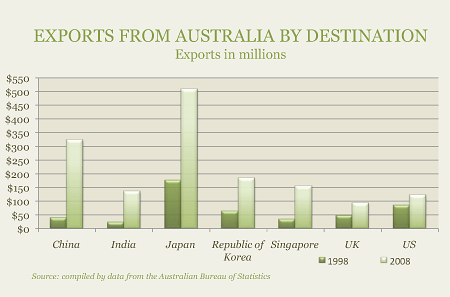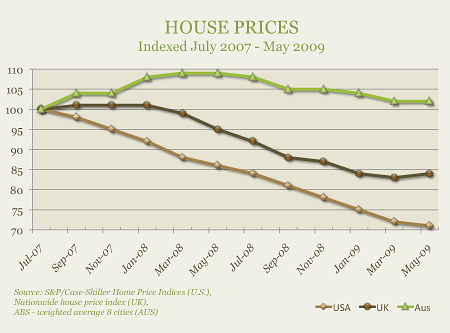They picked the
right trading partner
Ten years ago, the story for Australia might have been very
different. At that time, 70 percent of the country’s exports went to
the U.S., the U.K., and Japan.
Had Australia stayed hitched to these economies it almost
certainly would have been pulled down with them in the crisis. But as China
grew over the past decade, it became Australia’s No. 2 export market
(after Japan) — one hungry for Australia’s rich supply of
iron ore and one of the few economies to show significant growth through the
crisis years. (Although China’s GDP growth rate fell from a high of
13 percent, it has stayed above 6 percent, a rate that more established
economies would consider an outright boom.) In 2008, the year the crisis hit,
China absorbed AU$32 billion (or 15 percent) of Australia’s exports,
an eight-fold increase in 10 years.
The China Syndrome is often cited as the single most
important reason the Australian economy weathered the downturn. Economist Neal
Stoughton, head of banking and finance at the Australian School of Business,
argues that Australia had to do very little to stimulate the economy when the
crisis hit. The stimulus measures in Beijing were all that was needed, he
argued on a
href="http://blogs.bnetau.com.au/aussierules/2009/09/02/time-to-stop-the-stimulus-btalk-australia/">recent
edition of BTalk Australia on BNET.
As China's demand for raw materials grew it became Australia's No. 2 export market.
Their bankers
didn’t lose their minds
Australian banks proved to be more
resilient during the crisis because they hadn’t exposed themselves to
as much toxic debt as other nation’s financial institutions. The big
four banks (Australia and New Zealand Banking Group Limited, Commonwealth Bank
of Australia, National Bank of Australia and Westpac Banking Corporation)
stayed profitable, maintained their top credit ratings and
wrote down less than US$4 billion between them. In 2007, non-performing loans
were 0.2 percent of all Aussie bank loans, far lower than the U.K. (0.9
percent), U.S. (1.1 percent), and Germany (3.4 percent).
With Australia’s small population
(22 million, less than that of Texas) the banking sector faces little in the
way of competition. Non-bank lenders at their peak (just before the credit
squeeze) accounted for 20 percent of all loans. The banks did a good job of
grabbing most new home loans by cross-selling low-cost bank accounts, credit
cards and insurance — the more you bought the more you saved. That
gave home buyers less incentive to shop outside their bank for low-cost,
low-documentation mortgages.
When the credit crisis hit, Aussie banks
were able to raise short-term capital thanks to their strong credit ratings.
The government has helped, too, instituting a three-year uncapped bank deposit
guarantee in November 2008. Since then deposits shot up at an annual rate of 20
percent, another source of low-cost funds for the banks. In short, finding the
cash to survive has not been the struggle it has been elsewhere, and the focus
has been on growth not survival.
Their population kept
growing
When the world economy is in trouble, the
Aussie motto seems to be “throw people at it.” Economist
Saul Eslake from the Grattan Institute think tank believes this, not China, is
the main reason the country avoided a recession. He points out that per capita
economic output declined for four consecutive quarters, but because the
population grew, the economy still expanded. The first quarter of 2009 saw a
net growth of 97,000 immigrants, the highest since the figures were first
compiled in 1981. In the year to March 2009 the population grew by 2.1 percent
(63 percent of that came from immigration), compared to 0.88 percent in the
U.S. and 0.28 percent in the UK (2008 figures).
They skipped the
housing collapse
More Australians means more demand for
housing, and supply has not kept up. Authorities estimate that Australian
builders will have added 357,000 dwellings between 2008 and 2010; household growth
in metropolitan areas is expected to be more than two and a half times that.
The housing shortage helped keep prices buoyant: The 2008 decline in home
values was mild and the average home now fetches about 6% more than in mid-2007.
This is a major relief for Aussies who, like Americans, have the largest single
portion of their wealth tied up in the family home.
The RBA helped, too, by keeping interest
rates relatively high prior to the crisis. Cheap money helped fuel the bubble
in home prices in the U.S. and elsewhere, but in Australia, homes were simply
never inexpensive enough to attract an onrush of buyers. In January 2008,
Australians were paying 6.3 times their household annual earnings to buy a
house, compared with 3.6 times in the U.S.
The housing shortage in Australia has helped keep home prices steady.
So here’s
what recovery looks like
If Australia is indeed the first developed
country to emerge from the crisis, its economy offers a glimpse into what
recovery will look like in the U.S. and elsewhere — and the word “tentative”
comes to mind.
Even though Australians got off extremely
lightly by global standards, many were still traumatized by the downturn and
they’re not ready to trust that it’s over. Although a
jobless rate of 5.7 percent would seem like employment paradise to Americans
today, Australian Prime Minister Kevin Rudd publicly frets about it, just as
Barack Obama worries about 9.8 percent in the U.S. And while GDP and housing
markets held up remarkably well, both received assistance from government
stimulus programs. Australia has its equivalent of the U.S.’s
first-time home buyers credit, with an AU$14,000 grant for rookie home buyers,
which could go as high as AU$21,000 for brand-new homes. The OECD estimates
that the home buyer’s grant and other stimulus goodies, including a
big infrastructure project called the Nation Building program, saved 150,000 to
200,000 jobs that might otherwise have been lost. As in the U.S., no one is
quite sure how the economy will hold up when the life-support system is turned
off.
But to the extent that any recovery reflects
the decisions of individual business leaders to take risk again, Australia’s
rebound looks sustainable. In September, the National Australia Bank’s
monthly confidence survey found Aussie businesspeople more optimistic than they’ve
been since late 2003. Dunn and Bradstreet’s survey about the
fourth-quarter outlook shows that 46 percent of Australian businesses expect an
increase in sales and 31 percent expect an increase in profits. Some 20 percent
are planning to increase inventory over the same period and 16 percent expect
to hire.
And that’s enough to convince the
Australian School of Business’ economist Stoughton. Confidence
matters far more than government-funded infrastructure projects. “It’s
our medium- and long-term perception of job prospects that influence consumer’s
spending habits and employers’ hiring plans,” he says. So
Australia is leading the developed world not just in GDP and employment gains,
but also in the self-fulfilling prophecy that Keynes calls “animal
spirits”: faith that things will get better, which is a prerequisite
for their getting better for real.
There’s one
other way Australia’s recovery will look like those in the U.S. and
elsewhere. The Australian government borrowed a ton of money to stimulate the
economy (though debt, measured against GDP, is only about half as much as in
the U.S.). The inevitable cost of the government-fueled recoveries will be
higher taxes or higher inflation down the line. If only Australia can show the
world how to make a quick exit from that fate, too.
More on BNET
-
href="http://blogs.bnetau.com.au/aussierules/2009/09/24/guilty-g20-leaders-need-to-beat-protectionism-btalk-australia/"
title="Permanent Link to Guilty G20 Leaders Need to Beat Protectionism | BTalk Australia">Guilty
G20 Leaders Need to Beat Protectionism -
href="http://blogs.bnetau.com.au/aussierules/2009/09/02/time-to-stop-the-stimulus-btalk-australia/"
title="Permanent Link to Time to Stop the Stimulus | BTalk Australia">Time
to Stop the Stimulus -
href="http://blogs.bnetau.com.au/aussierules/2009/06/24/not-that-bad-say-private-companies-btalk-australia/"
title="Permanent Link to ">"Not That Bad" Say Private Companies -
href="http://blogs.bnetau.com.au/aussierules/2009/06/16/recovery-without-jobs-unlikely-btalk-australia/"
title="Permanent Link to Recovery Without Jobs, Unlikely | BTalk Australia">Recovery
Without Jobs, Unlikely

